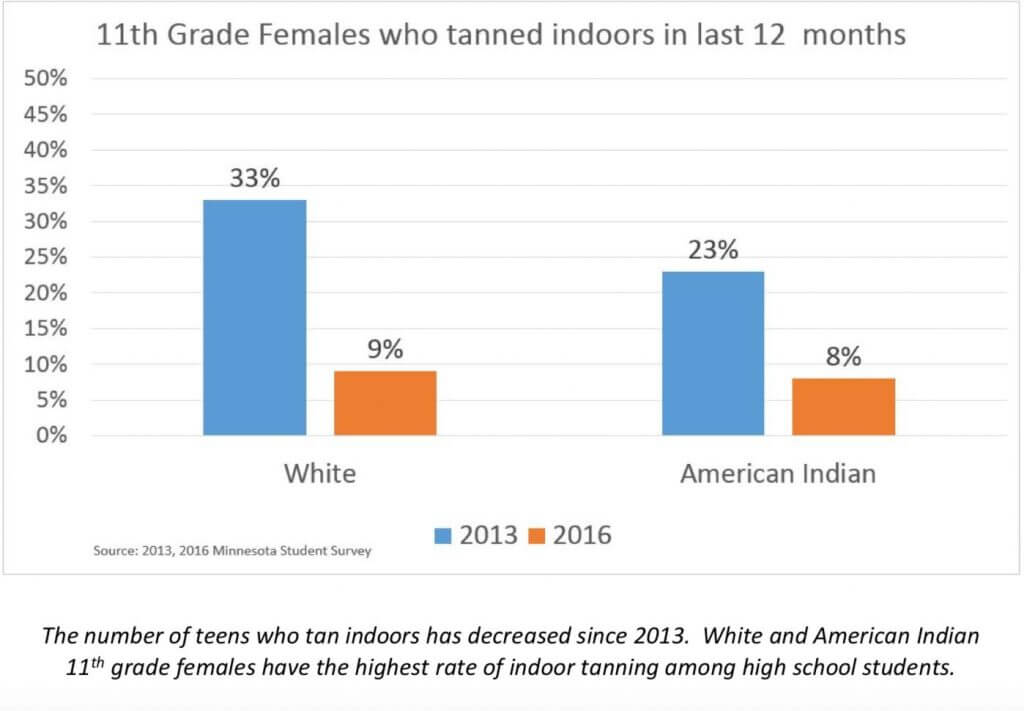Amidst the good news from the 2016 Minnesota Student Survey showing declines in youth smoking, drinking, drugs and sex, another risky behavior deserves mention. Indoor tanning use by 11th grade non-Hispanic white girls decreased 73%, from 33% in 2013 to 9% in 2016. This remarkable change in a cancer-causing risk factor came about through the collaborative efforts of Minnesota’s research, advocacy, medical and public health communities.

In 2002, 45% of women in Minnesota had used a tanning bed in their lifetime; many of these women were frequent users of indoor tanning, and about half had begun tanning indoors as adolescents. During this time, melanoma rates were increasing dramatically, both in Minnesota and nationally. Although previous research suggested a link between indoor tanning and melanoma, a potentially fatal form of skin cancer, the results were fraught with uncertainties due to the limitations of the studies. To improve upon the body of research on indoor tanning as a risk factor for melanoma, a large study was undertaken by the University of Minnesota between 2004 and 2009.
Over 2000 Minnesotans participated in the study, about half with melanoma and half without. After accounting for amount of sun exposure, previous sunburns, and other melanoma risk factors, the study documented that indoor tanners were 74% more likely to develop melanoma than people who did not tan indoors, that their risk of melanoma increased nearly 3-fold if they had tanned more than 100 times (easily achieved with twice a week tanning in a year), and that no type of indoor tanning device was safe. The results of this study greatly strengthened growing concerns that indoor tanning caused melanoma, and spurred action at the state, national and international levels. For example, the U.S. Surgeon General issued in 2014 a Call to Action to Prevent Skin Cancer, in which strategies were proposed to discourage indoor tanning use. Australia banned all commercial indoor tanning at the beginning of 2016.
In response to the evidence, policy initiatives to restrict youth access to indoor tanning were initiated. By 2014, 14 states had passed laws that prohibited minors from using indoor tanning facilities, Minnesota being one of them. The effort was initiated by the Minnesota Cancer Alliance. With the American Cancer Society taking the lead, the law passed and went into effect on July 1, 2014. Educational efforts were also targeted at high schools, with webinars and video contests.
Improvements to the state law and greater educational efforts regarding the health risks of indoor tanning may yet be needed to eliminate this risky behavior among girls in Minnesota. Nevertheless, Minnesota can be proud of its contribution to the science and being among the first wave of states to recognize and take action against this harmful exposure.
The Minnesota Cancer Alliance is grateful for this significant foundation for Objective 16 in Cancer Plan Minnesota: Reduce exposure to ultraviolet light. The groundwork has been accomplished to achieve Strategies 16.2 Strengthen existing laws governing indoor tanning facilities and 16.3 Conduct an education campaign on the harms of indoor tanning.
Contributed by:
DeAnn Lazovich, Ph.D.
MCA Steering Committee Member and
Associate Professor
Division of Epidemiology and Community Health University of Minnesota
1300 S. 2nd Street, #300
Minneapolis, MN 55454
(612) 626-9099 (office)

